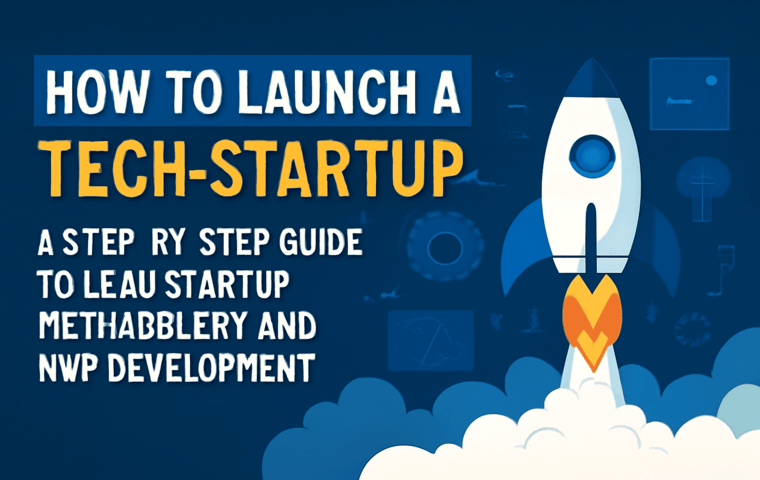Currently Empty: $0.00

A Step-by-Step Guide to Lean Start-up Methodology and MVP Development for Starting a Tech Company
Starting a digital business is an exciting thing to do, but the road to success is typically full of problems. There are a lot of things that entrepreneurs don’t know for sure, especially when it comes to making products, finding the right market, and making sure their business is financially stable.
We will show you how to use the Lean Startup Methodology and make your Minimum Viable Product (MVP) in this detailed tutorial. To establish a tech startup successfully, cut down on waste, and improve your prospects of long-term success, you need to use these tactics.
This step-by-step guide will give you the information you need to get through the startup process, whether you’re a first-time entrepreneur or a seasoned business owner trying to improve your approach.
What is the Lean Start-up Method?
The Lean Startup Methodology is a scientific way to establish and run a business. By focusing on validated learning, rapid prototyping, and user feedback, it helps entrepreneurs lower their risk and uncertainty.
The main ideas behind the Lean Startup Methodology are:
The Lean Startup method is based on the Build-Measure-Learn cycle. It encourages people to quickly test and improve their ideas before spending a lot of time and money on development. There are three main steps in the cycle:
- Build: Make a product or feature with as few resources as possible.
- Measure: Get input from real users by using surveys, data analysis, and feedback loops.
- Learn: Check to see if your assumptions were right, make changes to the product, and do it all over again.
Validated Learning: Lean entrepreneurs don’t just guess what customers want; they use facts from the actual world to check their ideas. This process of learning again and over again makes sure that you are tackling the proper challenges and meeting consumer needs.
If early tests demonstrate that your assumptions are wrong, it might be time to pivot, which means making a big adjustment to your product or strategy. If the data shows you’re on the right track, though, keep going and improve the product.
Example from the real world:
A well-known example of a lean startup is Dropbox. Drew Houston, the founder, made a short video demo instead of a fully built product to start. He utilized the video to see how interested people were and get their input, which helped him make the full product.
What is a Minimum Viable Product (MVP)?
An MVP is a version of your product that has only the most important features that your target users need. It’s the fastest method to get a working version of your product out there and see how well it works with actual people.
What an MVP Does in the Lean Startup Method
The MVP is a key part of the Lean Startup technique because it lets business owners quickly test and confirm their ideas without spending a lot of money on product development.
Some of the best things about an MVP are:
- Lower Costs: You don’t squander time or money making features that clients don’t want.
- Faster Time to Market: You may put a product out sooner, get feedback right away, and make changes as needed.
- Real User Feedback: An MVP lets you hear directly from your audience, which helps you figure out what works and what doesn’t.
Example from the real world:
Another wonderful example of how an MVP works in real life is Airbnb. The creators didn’t have a complete platform when they first started. They didn’t do that. Instead, they took pictures of their flat and put them on Craigslist, where they offered guests a place to stay. They kept working on the product based on user feedback and interest until it became the platform we know today.
How to Build a Lean Startup using the MVP Method
Now that you know the basics of Lean Startup and MVP development, let’s go through the steps of starting your own tech company.
Step 1: Find the problem and the solution
You need to know exactly what problem you’re trying to solve and how your solution can help with that problem before you start constructing anything. This is an important part of both the Lean Startup method and the process of making an MVP.
Important Questions to Answer:
- What issue are you fixing?
- Who do you want to reach?
- What is the easiest way to fix this?
Step 2: Come up with your MVP idea
Now that you know what the problem is, it’s time to come up with a basic idea for your MVP. Keep in mind that your MVP doesn’t have to be perfect; it only has to show that your product idea has promise.
Important Steps in Making an MVP:
- List the Most Important Features: Find the main elements that will immediately help your target users solve their problem. Anything else is not necessary for the MVP.
- Make the User Interface Simple: Keep it simple and useful. Your MVP’s primary value can be lost if the UI is too sophisticated.
- Make plans for future iterations: Your MVP should be the starting point for future upgrades and improvements.
Step 3: Make the MVP and get it out there
Now that you have a clear idea of what your MVP will be, it’s time to make and release your product. The goal is to release the simplest version of your product that has the most important functionality needed to solve the problem.
Here are some tips for making an MVP:
- Use Lean Tools: There are a lot of tools you can use to quickly design and test your MVP. For quick MVP development, Figma is wonderful for design, Bubble is ideal for no-code development, and Shopify is great for e-commerce.
- Focus on the Core Features: Don’t add superfluous features that don’t help solve the main problem.
Step 4: Measure and Learn
It’s time to start measuring and gathering data after your MVP is up and running. This is when the Build-Measure-Learn cycle comes in.
Important Metrics to Keep an Eye On:
- User Engagement: Are people using your MVP? Are they using the main features you’ve made?
- Customer Feedback: Get qualitative feedback through surveys, interviews, and support tickets.
- Conversion Rates: Are people signing up, buying things, or doing what you want them to do?
Step 5: Change direction or keep going
You will have to choose whether to pivot or keep on based on the facts you get.
- Pivot: It’s time to pivot if users aren’t using your MVP or if your first guesses turn out to be erroneous. For example, you could have to adjust who you’re trying to reach, improve the features of your product, or even convert to a new business model.
- Keep going: If the feedback shows that your MVP is meeting consumers’ needs, it’s time to improve it and make it even better.
An example of pivoting in the real world:
Odeo was a podcasting site that later became Twitter. But when Apple started its podcast service, the people who started Odeo knew they had to change their plans. They moved to a microblogging site, which is what we know today as a successful product.
Tools and resources for Lean Startup
Here are some valuable tools and resources that might help you grow and run your digital startup:
- Tools for developing customers:
-
- SurveyMonkey: Use this to get feedback from users.
- Typeform: Make surveys and forms that people want to fill out.
- Tools for developing products:
-
- Trello/Asana: Keep track of the tasks and milestones for your MVP development.
- Sketch/Figma: Make wireframes and prototypes for your MVP.
- Tools for Analytics:
-
- Google Analytics: Keep an eye on what users do and how they act on your MVP.
- Mixpanel: Gives you more detailed data to help you figure out what users are doing.
Starting a tech company is a fascinating adventure with a lot of problems, but if you do it well, it can lead to great success. You can lower your risk, save money, and test your ideas more quickly by employing the Lean Startup Methodology and focusing on building an MVP.
First, figure out what the main problem is, then make a small MVP, and finally make changes based on what real customers say. Keep in mind that the path of entrepreneurship is seldom straight. You will be successful if you can learn and change rapidly.
Stay flexible, stay focused, and keep improving your offering based on what your customers really want.
Good luck with your tech startup!






